Possible Impact of Early Spring Arctic Sea Ice on Meiyu Cessation over the Yangtze–Huaihe River Basin
Abstract
:1. Introduction
2. Data and Methods
2.1. Data
2.2. Methodology
3. Results
3.1. Circulation Background Tied to the Interannual Meiyu Cessation
3.2. Relationship between Inter-Annual Variations of Meiyu Cessation and Early Spring Arctic Sea Ice
3.3. Underlying Physical Pathway of How Early Spring Arctic Sea Ice Modulates Meiyu Cessation
4. Conclusions and Discussions
4.1. Conclusions
4.2. Discussions
Author Contributions
Funding
Institutional Review Board Statement
Informed Consent Statement
Data Availability Statement
Conflicts of Interest
References
- Tao, S.; Chen, L. A Review of Recent Research on the East Asian Summer Monsoon in China. Monsoon Meteorology; Chang, C.-P., Krishnamurti, T.N., Eds.; Oxford University Press: New York, NY, USA, 1987; pp. 60–92. [Google Scholar]
- Lau, K.M.; Yang, G.J.; Shen, S.H. Seasonal and intraseasonal climatology of summer monsoon rainfall over East Asia. Mon. Weather. Rev. 1988, 116, 18–37. [Google Scholar] [CrossRef]
- Enomoto, T.; Hoskins, B.J.; Matsuda, Y. The formation mechanism of the Bonin high in August. Q. J. R. Meteorol. Soc. 2003, 129, 157–178. [Google Scholar] [CrossRef]
- Ding, Y.; Chan, J.C.L. The East Asian summer monsoon: An overview. Meteorol. Atmos. Phys. 2005, 89, 117–142. [Google Scholar] [CrossRef]
- Ninomiya, K.; Shibagaki, Y. Multi-scale features of the Meiyu-Baiu front and associated precipitation systems. J. Meteorol. Soc. Jpn. 2007, 85, 103–122. [Google Scholar] [CrossRef]
- Ding, Y.; Wang, Z. A study of rainy seasons in China. Meteorol. Atmos. Phys. 2008, 100, 121–138. [Google Scholar] [CrossRef]
- Ding, Y.; Wang, Z.; Sun, Y. Inter-decadal variation of the summer precipitation in East China and its association with decreasing Asian summer monsoon. Part I: Observed evidences. Int. J. Climatol. 2008, 28, 1139–1161. [Google Scholar] [CrossRef]
- Ding, Y.; Sun, Y.; Wang, Z.; Zhu, Y.; Song, Y. Inter-decadal variation of the summer precipitation in China and its association with decreasing Asian summer monsoon Part II: Possible causes. Int. J. Climatol. 2009, 29, 1926–1944. [Google Scholar] [CrossRef]
- Wang, J.; He, J.; Liu, X.; Wu, B. Interannual variability of the Meiyu onset over Yangtze-Huaihe River Valley and analyses of its previous strong influence signal. Chin. Sci. Bull. 2009, 54, 687–695. [Google Scholar] [CrossRef]
- Kosaka, Y.; Xie, S.P.; Nakamura, H. Dynamics of interannual variability in summer precipitation over East Asia. J. Clim. 2011, 24, 5435–5453. [Google Scholar] [CrossRef]
- Choi, K.S.; Kang, S.D.; Kim, H.D. Multiple linear regression model for the prediction of Changma onset date in Korea. Int. J. Climatol. 2014, 34, 1000–1010. [Google Scholar] [CrossRef]
- Choi, J.W.; Lee, J.S.; Moon, I.J. Second Changma retreat variability in Korea using the available water resources index and relevant large-scale atmospheric circulation. Int. J. Climatol. 2016, 36, 2273–2287. [Google Scholar] [CrossRef]
- Chiang, J.C.H.; Kong, W.; Wu, C.H.; Battisti, D.S. Origins of East Asian summer monsoon seasonality. J. Clim. 2020, 33, 7945–7965. [Google Scholar] [CrossRef]
- Choi, J.W.; Kim, H.D.; Wang, B. Interdecadal variation of Changma (Korean summer monsoon rainy season) retreat date in Korea. Int. J. Climatol. 2020, 40, 1348–1360. [Google Scholar] [CrossRef]
- Ding, Y.; Liang, P.; Liu, Y.; Zhang, Y. Multiscale variability of Meiyu and its prediction: A new review. J. Geophys. Res. Atmos. 2020, 125, e2019JD031496. [Google Scholar] [CrossRef]
- Wang, J.; Liu, Y.; Ding, Y.; Wu, Z. Towards influence of Arabian Sea SST anomalies on the withdrawal date of Meiyu over the Yangtze-Huaihe River basin. Atmos. Res. 2021, 249, 105340. [Google Scholar] [CrossRef]
- Ninomiya, K.; Akiyama, T. Multi-scale features of Baiu, the summer monsoon over Japan and the East Asia. J. Meteorol. Soc. Japan. Ser. II 1992, 70, 467–495. [Google Scholar] [CrossRef]
- Sampe, T.; Xie, S.P. Large-scale dynamics of the Meiyu-Baiu rainband: Environmental forcing by the westerly jet. J. Clim. 2010, 23, 113–134. [Google Scholar] [CrossRef]
- Li, Y.; Deng, Y.; Yang, S.; Zhang, H. Multi-scale temporospatial variability of the East Asian Meiyu-Baiu fronts: Characterization with a suite of new objective indices. Clim. Dyn. 2018, 51, 1659–1670. [Google Scholar] [CrossRef]
- Yao, Y.; Lin, H.; Wu, Q. Linkage between interannual variation of the East Asian intraseasonal oscillation and Mei-Yu onset. J. Clim. 2018, 32, 145–160. [Google Scholar] [CrossRef]
- Ding, Y.; Liu, Y.; Hu, Z.Z. The record-breaking Mei-Yu in 2020 and associated atmospheric circulation and tropical SST anomalies. Adv. Atmos. Sci. 2021, 38, 1980–1993. [Google Scholar] [CrossRef]
- Guan, P.; Chen, G.; Zeng, W.; Liu, Q. Corridors of Mei-Yu-season rainfall over eastern China. J. Clim. 2020, 33, 2603–2626. [Google Scholar] [CrossRef]
- Ding, Y. Summer monsoon rainfalls in China. J. Meteorol. Soc. Jpn. 1992, 70, 373–396. [Google Scholar] [CrossRef]
- Chen, X.; Dai, A.; Wen, Z.; Song, Y. Contributions of Arctic Sea ice loss and East Siberian atmospheric blocking to 2020 record-breaking Meiyu-Baiu rainfall. Geophys. Res. Lett. 2021, 48, e2021GL092748. [Google Scholar] [CrossRef]
- Chen, X.; Wen, Z.; Song, Y.; Guo, Y. Causes of extreme 2020 Meiyu-Baiu rainfall: A study of combined effect of Indian Ocean and Arctic. Clim. Dyn. 2022, 1–17. [Google Scholar] [CrossRef]
- Zhou, Z.K. Analyses and Prediction of Meiyu in Yangtze-Huaihe River Valley; Meteorological Press: Beijing, China, 2006; pp. 1–184. (In Chinese) [Google Scholar]
- Zhang, R.; Min, Q.; Su, J. Impact of El Niño on atmospheric circulations over East Asia and rainfall in China: Role of the anomalous western North Pacific anticyclone. Sci. China Earth Sci. 2017, 60, 1124–1132. [Google Scholar] [CrossRef]
- Zhou, Z.Q.; Xie, S.P.; Zhang, R. Historic Yangtze flooding of 2020 tied to extreme Indian Ocean conditions. Proc. Natl. Acad. Sci. USA 2021, 118, e2022255118. [Google Scholar] [CrossRef]
- Li, H.; He, S.; Fan, K.; Wang, H. Relationship between the onset date of the Meiyu and the South Asian anticyclone in April and the related mechanisms. Clim. Dyn. 2019, 52, 209–226. [Google Scholar] [CrossRef]
- Xie, Z.; Du, Y.; Zeng, Y.; Miao, Q. Classification of yearly extreme precipitation events and associated flood risk in the Yangtze-Huaihe River Valley. Sci. China Earth Sci. 2018, 61, 1341–1356. [Google Scholar] [CrossRef]
- Burgan, H.I.; Icaga, Y. Flood analysis using Adaptive Hydraulics (AdH) model in Akarcay Basin. Tek. Dergi 2019, 30, 9029–9051. [Google Scholar] [CrossRef]
- Chen, T.; Zhang, F.; Yu, C.; Ma, J.; Zhang, X.; Shen, X.; Zhang, F.; Luo, Q. Synoptic analysis of extreme Meiyu precipitation over Yangtze River Basin during June–July 2020. Meteorol. Mon. 2020, 46, 1415–1426. (In Chinese) [Google Scholar] [CrossRef]
- Liang, P.; Hu, Z.Z.; Ding, Y.; Qian, Q. The extreme Mei-Yu season in 2020: Role of the Madden-Julian oscillation and the cooperative influence of the Pacific and Indian Oceans. Adv. Atmos. Sci. 2021, 38, 2040–2054. [Google Scholar] [CrossRef]
- Wang, L.; Sun, X.; Yang, X.; Tao, L.; Zhang, Z. Contribution of water vapor to the record-breaking extreme Meiyu rainfall along the Yangtze River Valley in 2020. J. Meteorol. Res. 2021, 35, 557–570. [Google Scholar] [CrossRef]
- Liu, B.; Yan, Y.; Zhu, C.; Ma, S.; Li, J. Record-breaking Meiyu rainfall around the Yangtze River in 2020 regulated by the subseasonal phase transition of the North Atlantic oscillation. Geophys. Res. Lett. 2020, 47, e2020GL090342. [Google Scholar] [CrossRef]
- Qiao, S.; Chen, D.; Wang, B.; Cheung, H.N.; Liu, F.; Cheng, J.; Tang, S.; Zhang, Z.; Feng, G.; Dong, W. The longest 2020 Meiyu season over the past 60 years: Subseasonal perspective and its predictions. Geophys. Res. Lett. 2021, 48, e2021GL093596. [Google Scholar] [CrossRef]
- Takaya, Y.; Ishikawa, I.; Kobayashi, C.; Endo, H.; Ose, T. Enhanced Meiyu-Baiu rainfall in early summer 2020: Aftermath of the 2019 super IOD event. Geophys. Res. Lett. 2020, 47, e2020GL090671. [Google Scholar] [CrossRef]
- Guo, Y.; Zhang, R.; Wen, Z.; Li, J.; Zhang, C.; Zhou, Z. Understanding the role of SST anomaly in extreme rainfall of 2020 Meiyu season from an interdecadal perspective. Sci. China Earth Sci. 2021, 64, 1619–1632. [Google Scholar] [CrossRef]
- Tang, S.; Luo, J.J.; He, J.; Wu, J.; Zhou, Y.; Ying, W. Toward understanding the extreme floods over Yangtze River Valley in June–July 2020: Role of tropical oceans. Adv. Atmos. Sci. 2021, 38, 2023–2039. [Google Scholar] [CrossRef]
- Ueda, H.; Yokoi, M.; Kuramochi, M. Enhanced subtropical anticyclone over the Indo–Pacific Ocean associated with stagnation of the Meiyu–Baiu rainband during summer, 2020. SOLA 2021, 17, 14–18. [Google Scholar] [CrossRef]
- Zheng, J.; Wang, C. Influences of three oceans on record-breaking rainfall over the Yangtze River Valley in June 2020. Sci. China Earth Sci. 2021, 64, 1607–1618. [Google Scholar] [CrossRef]
- Cai, Y.; Chen, Z.; Du, Y. The role of Indian Ocean warming on extreme rainfall in central China during early summer 2020: Without significant El Niño influence. Clim. Dyn. 2022, 59, 951–960. [Google Scholar] [CrossRef]
- Liu, C.; Hu, C.; Yang, S.; Lin, L.; Wu, Z. Super East Asian monsoon Mei-yu in June and July 2020 tied to dissimilar-shifting upper-level westerlies. Atmos. Res. 2022, 274, 106213. [Google Scholar] [CrossRef]
- Kripalani, R.; Ha, K.J.; Ho, C.H.; Oh, J.H.; Preethi, B.; Mujumdar, M.; Prabhu, A. Erratic Asian summer monsoon 2020: COVID-19 lockdown initiatives possible cause for these episodes? Clim. Dyn. 2022, 59, 1339–1352. [Google Scholar] [CrossRef]
- Yang, Y.; Ren, L.; Wu, M.; Wang, H.; Song, F.; Leung, L.R.; Hao, X.; Li, J.; Chen, L.; Li, H.; et al. Abrupt emissions reductions during COVID-19 contributed to record summer rainfall in China. Nat. Commun. 2022, 13, 959. [Google Scholar] [CrossRef]
- Huang, Q.; Wang, L.; Li, Y.; He, J. Determination of the onset and ending of regional Meiyu over Yangtze-Huaihe River Valley and its characteristics. J. Trop. Meteorol. 2012, 28, 749–756. (In Chinese) [Google Scholar]
- Nitta, T. Convective activities in the tropical western Pacific and their impact on the Northern Hemisphere summer circulation. J. Meteorol. Soc. Jpn. 1987, 65, 373–390. [Google Scholar] [CrossRef]
- Wang, C. Three-ocean interactions and climate variability: A review and perspective. Clim. Dyn. 2019, 53, 5119–5136. [Google Scholar] [CrossRef]
- Wu, B.; Zhang, R.; Wang, B.; D’Arrigo, R. On the association between spring Arctic Sea ice concentration and Chinese summer rainfall. Geophys. Res. Lett. 2009, 36, L09501. [Google Scholar] [CrossRef]
- Wu, B.; Zhang, R.; Ding, Y.; D’Arrigo, R. Distinct modes of the East Asian summer monsoon. J. Clim. 2008, 21, 1122–1138. [Google Scholar] [CrossRef]
- Zhang, J.; Tian, W.; Chipperfield, M.P.; Xie, F.; Huang, J. Persistent shift of the Arctic polar vortex towards the Eurasian continent in recent decades. Nat. Clim. Chang. 2016, 6, 1094–1099. [Google Scholar] [CrossRef]
- Xu, M.; Tian, W.; Zhang, J.; Wang, T.; Qie, K. Impact of sea ice reduction in the Barents and Kara Seas on the variation of the East Asian trough in late winter. J. Clim. 2021, 34, 1081–1097. [Google Scholar] [CrossRef]
- Han, T.; Zhang, M.; Zhu, J.; Zhou, B.; Li, S. Impact of early spring sea ice in Barents Sea on midsummer rainfall distribution at Northeast China. Clim. Dyn. 2021, 57, 1023–1037. [Google Scholar] [CrossRef]
- Kalnay, E.; Kanamitsu, M.; Kistler, R.; Collins, W.; Deaven, D.; Gandin, L.; Iredell, M.; Saha, S.; White, G.; Woollen, J.; et al. The NCEP/NCAR 40-year reanalysis project. Bull. Am. Meteorol. Soc. 1996, 77, 437–471. [Google Scholar] [CrossRef]
- Liebmann, B.; Smith, C.A. Description of a complete (interpolated) outgoing longwave radiation dataset. Bull. Am. Meteorol. Soc. 1996, 77, 1275–1277. [Google Scholar] [CrossRef]
- Xie, P.; Arkin, P.A. Global precipitation: A 17-year monthly analysis based on gauge observations, satellite estimates, and numerical model outputs. Bull. Am. Meteorol. Soc. 1997, 78, 2539–2558. [Google Scholar] [CrossRef]
- Rayner, N.A.; Parker, D.E.; Horton, E.B.; Folland, C.K.; Alexander, L.V.; Rowell, D.P.; Kent, E.C.; Kaplan, A. Global analyses of sea surface temperature, sea ice, and night marine air temperature since the late nineteenth century. J. Geophys. Res. 2003, 108, 4407. [Google Scholar] [CrossRef]
- Kay, J.E.; Deser, C.; Phillips, A.; Mai, A.; Hannay, C.; Strand, G.; Arblaster, J.M.; Bates, S.C.; Danabasoglu, G.; Edwards, J.; et al. The community earth system model (CESM) large ensemble project: A community resource for studying climate change in the presence of internal climate variability. Bull. Am. Meteorol. Soc. 2015, 96, 1333–1349. [Google Scholar] [CrossRef]
- Zheng, X.T.; Hui, C.; Yeh, S.W. Response of ENSO amplitude to global warming in CESM large ensemble: Uncertainty due to internal variability. Clim. Dyn. 2018, 50, 4019–4035. [Google Scholar] [CrossRef]
- Piao, J.; Chen, W.; Chen, S.; Gong, H. Role of the internal atmospheric variability on the warming trends over Northeast Asia during 1970–2005. Theor. Appl. Climatol. 2022, 1–12. [Google Scholar] [CrossRef]
- Sardeshmukh, P.D.; Hoskins, B.J. The generation of global rotational flow by steady idealized tropical divergence. J. Atmos. Sci. 1988, 45, 1228–1251. [Google Scholar] [CrossRef]
- Takaya, K.; Nakamura, H. A formulation of a phase-independent wave-activity flux for stationary and migratory quasigeostrophic eddies on a zonally varying basic flow. J. Atmos. Sci. 2001, 58, 608–627. [Google Scholar] [CrossRef]
- Liu, Y.; Ding, Y.; Song, Y. Relationship between the Meiyu over the Yangtze-Huaihe River Basins and the frequencies of tropical cyclone genesis in the western North Pacific. J. Meteorol. Soc. Jpn. 2011, 89, 141–152. [Google Scholar] [CrossRef]
- Huangfu, J.; Tang, Y.; Wang, L.; Chen, W.; Huang, R.; Ma, T. Joint influence of the quasi-biennial oscillation and Indian Ocean basin mode on tropical cyclone occurrence frequency over the western North Pacific. Clim. Dyn. 2022, 1–11. [Google Scholar] [CrossRef]
- Li, X.; Lu, R. Breakdown of the summertime meridional teleconnection pattern over the western North Pacific and East Asia since the early 2000s. J. Clim. 2020, 33, 8487–8505. [Google Scholar] [CrossRef]
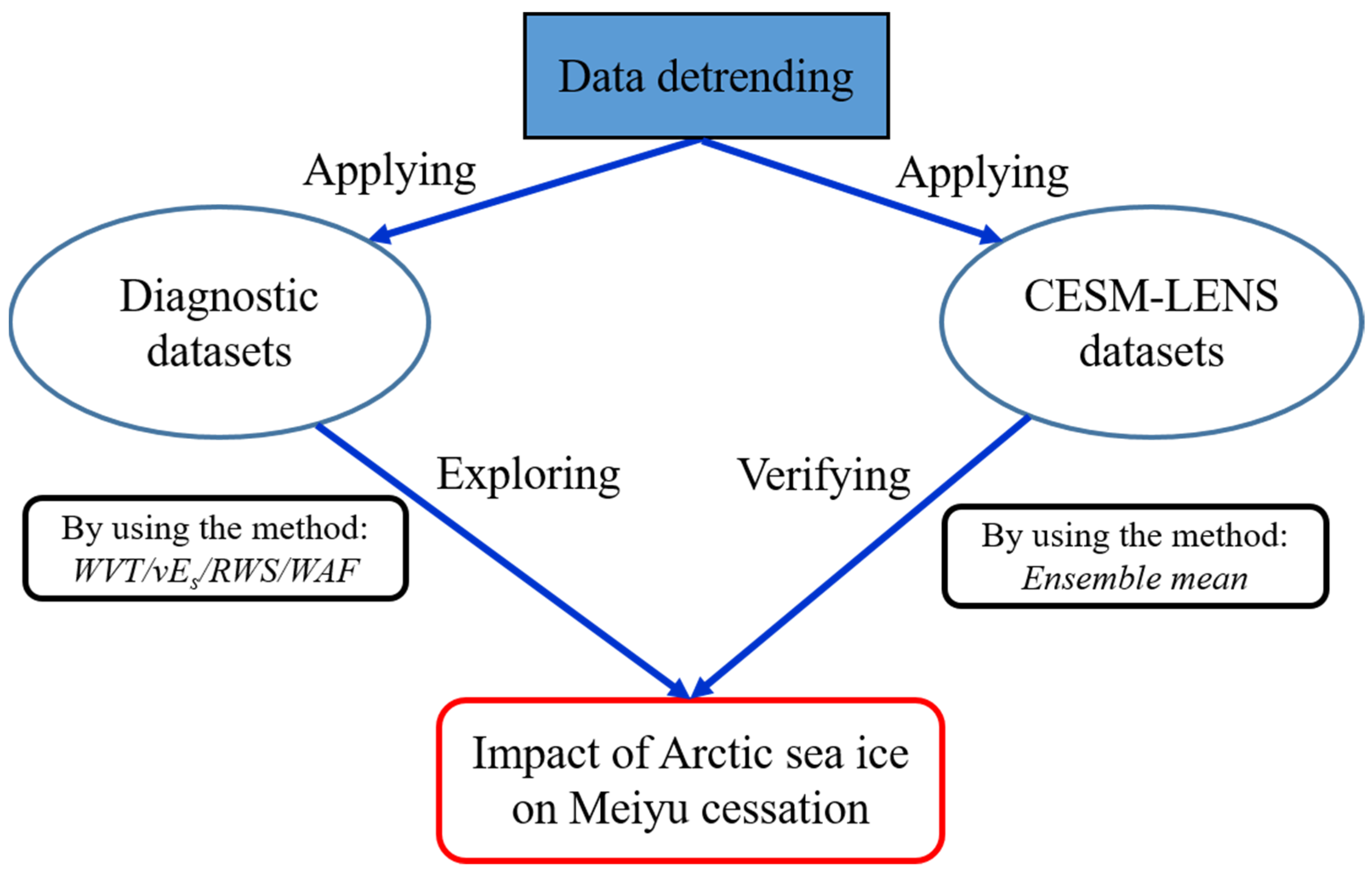
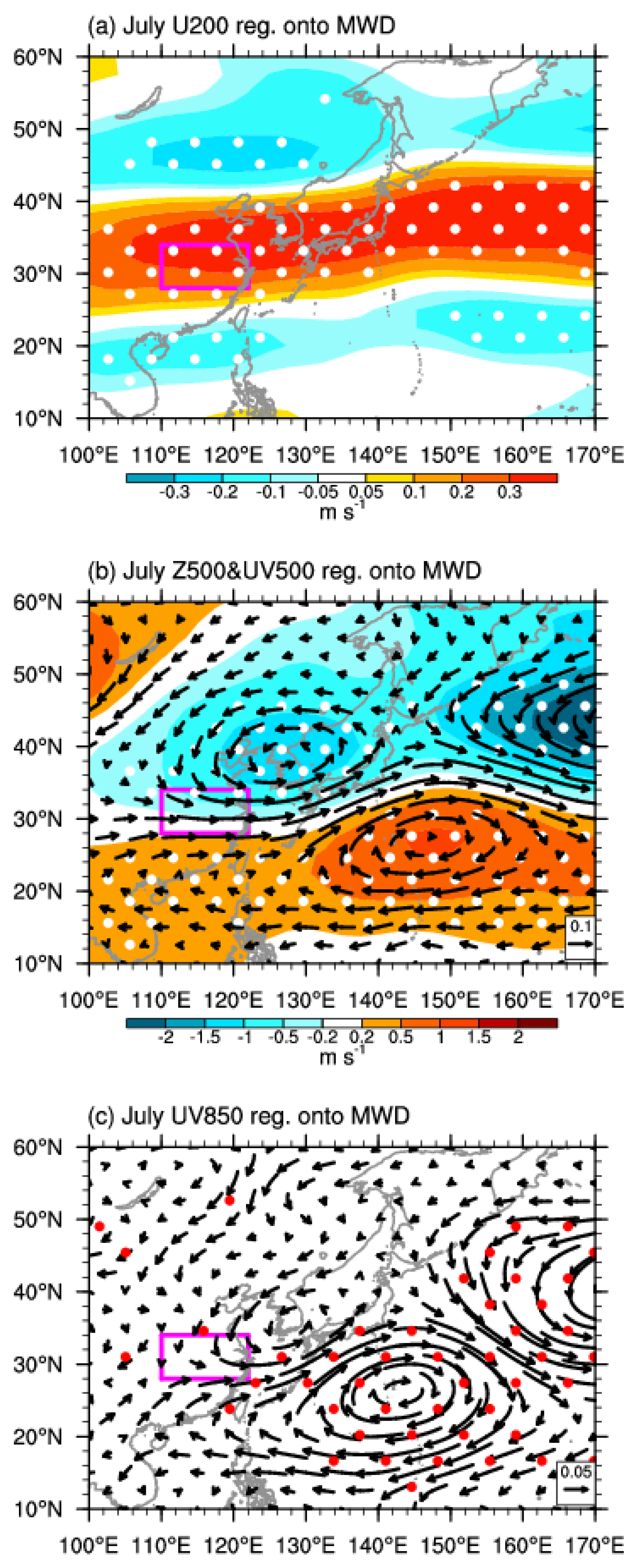
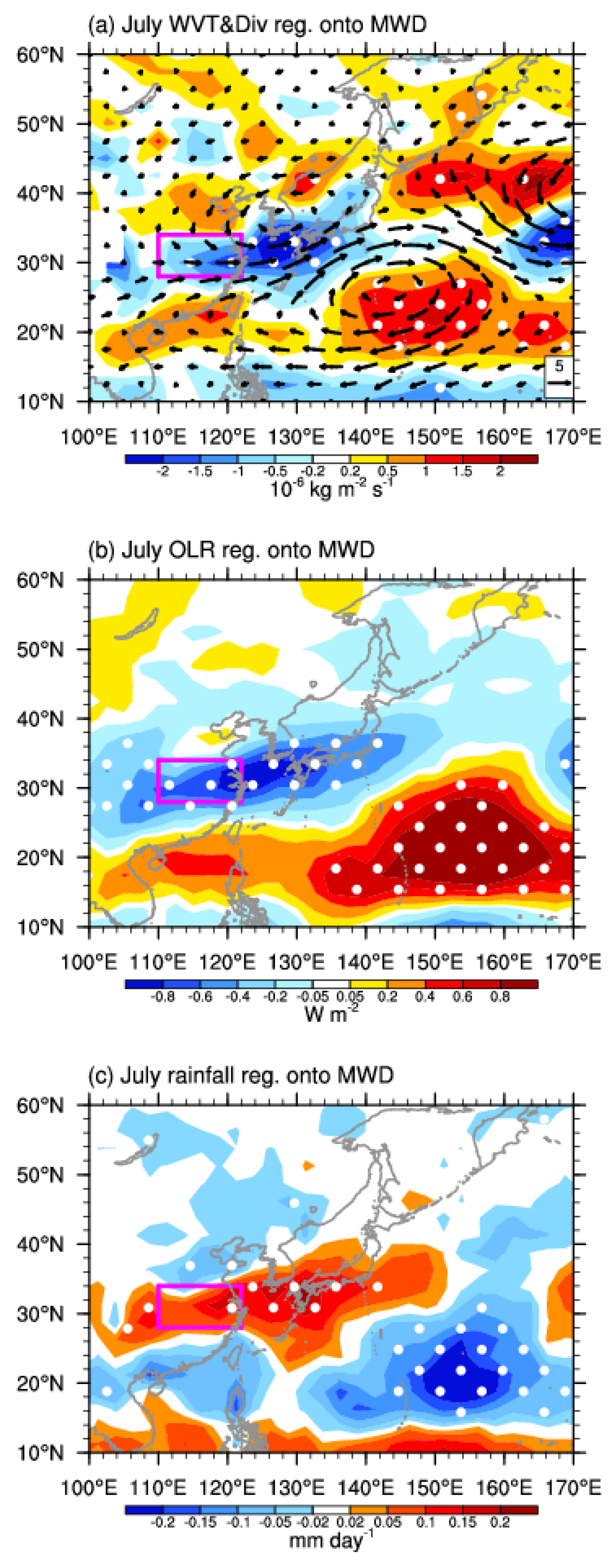
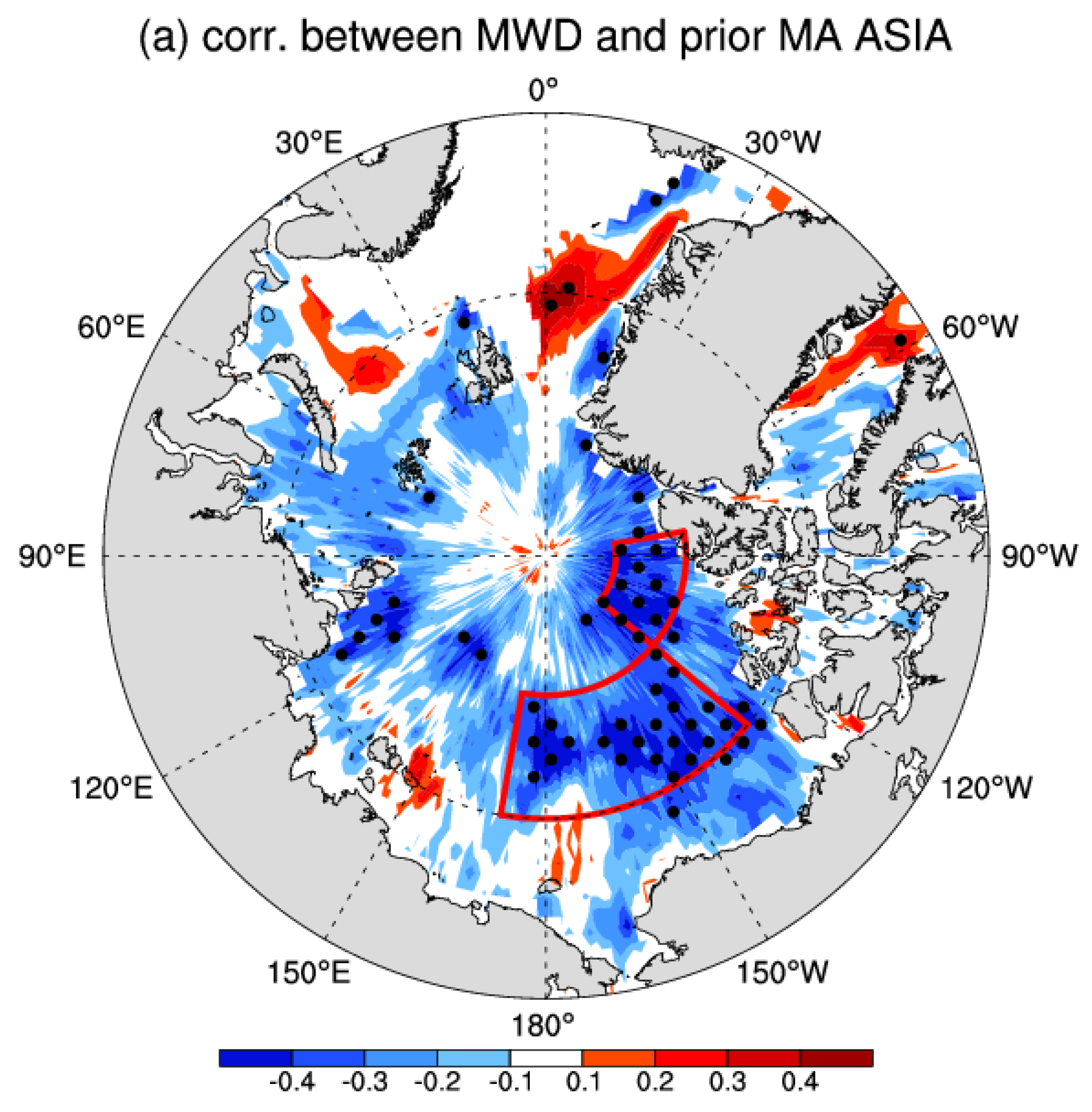
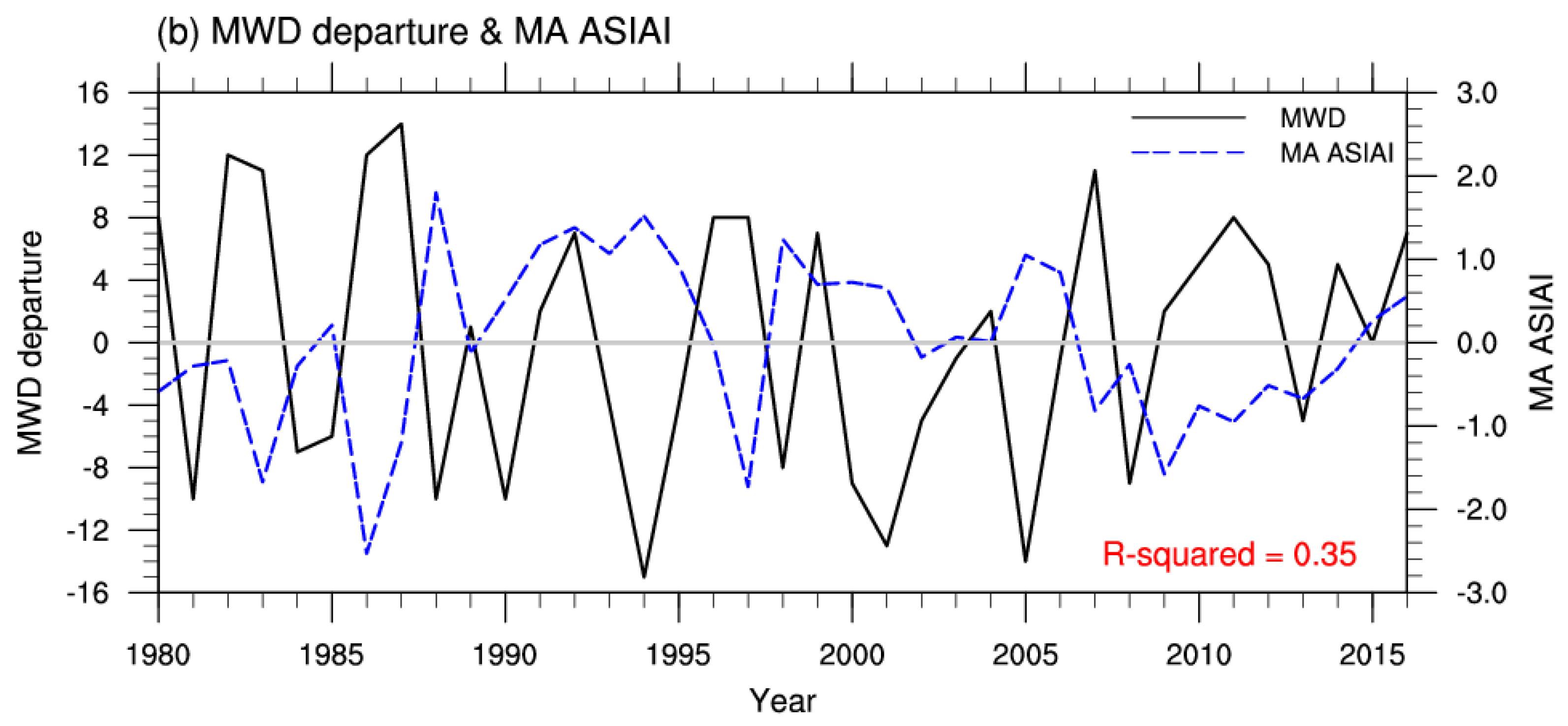

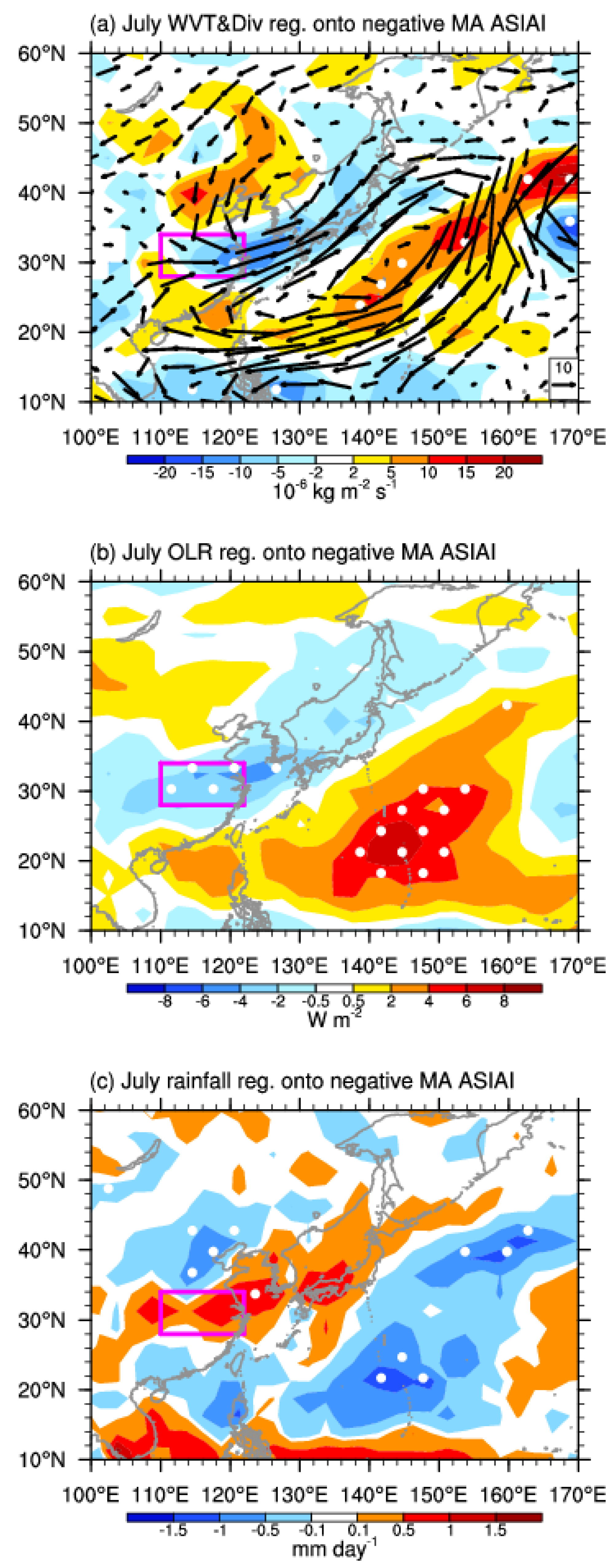
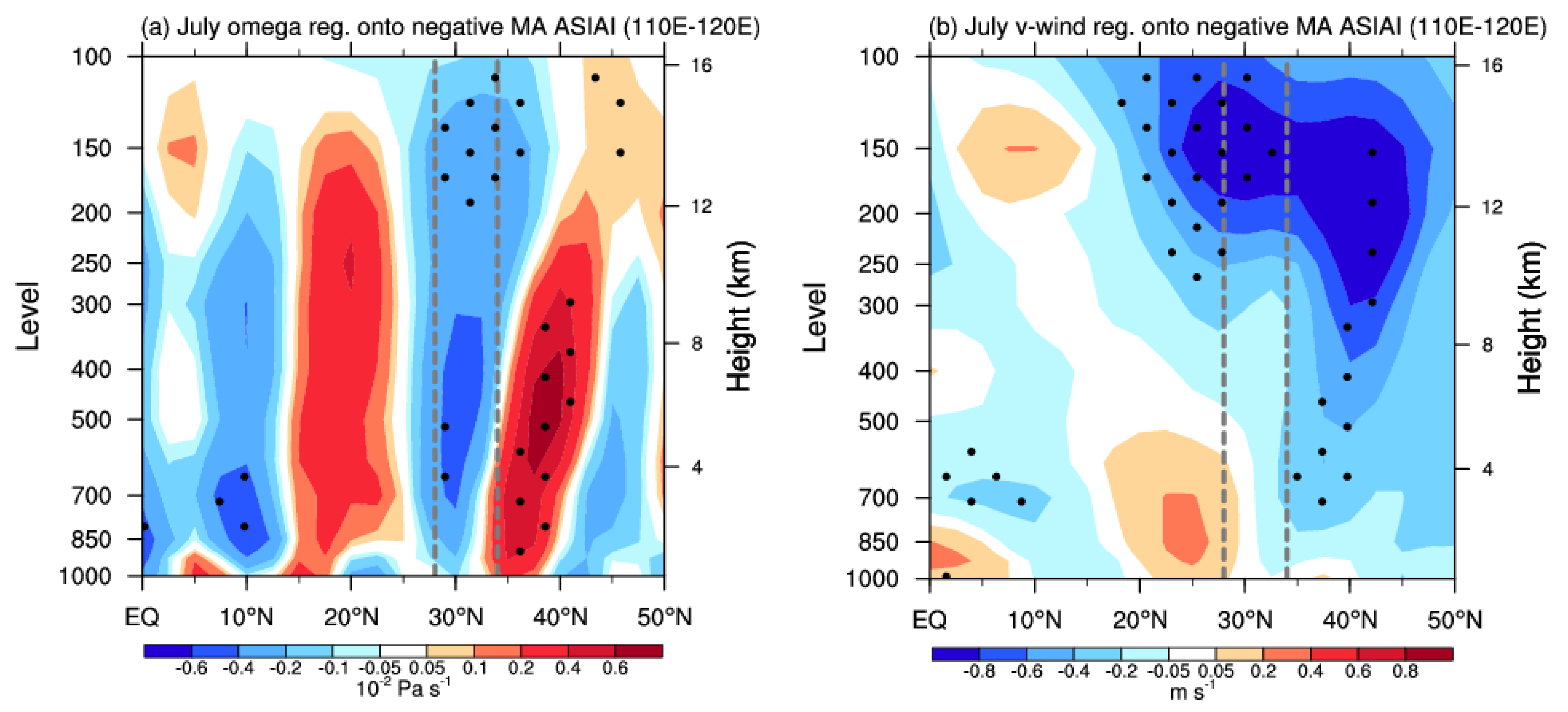
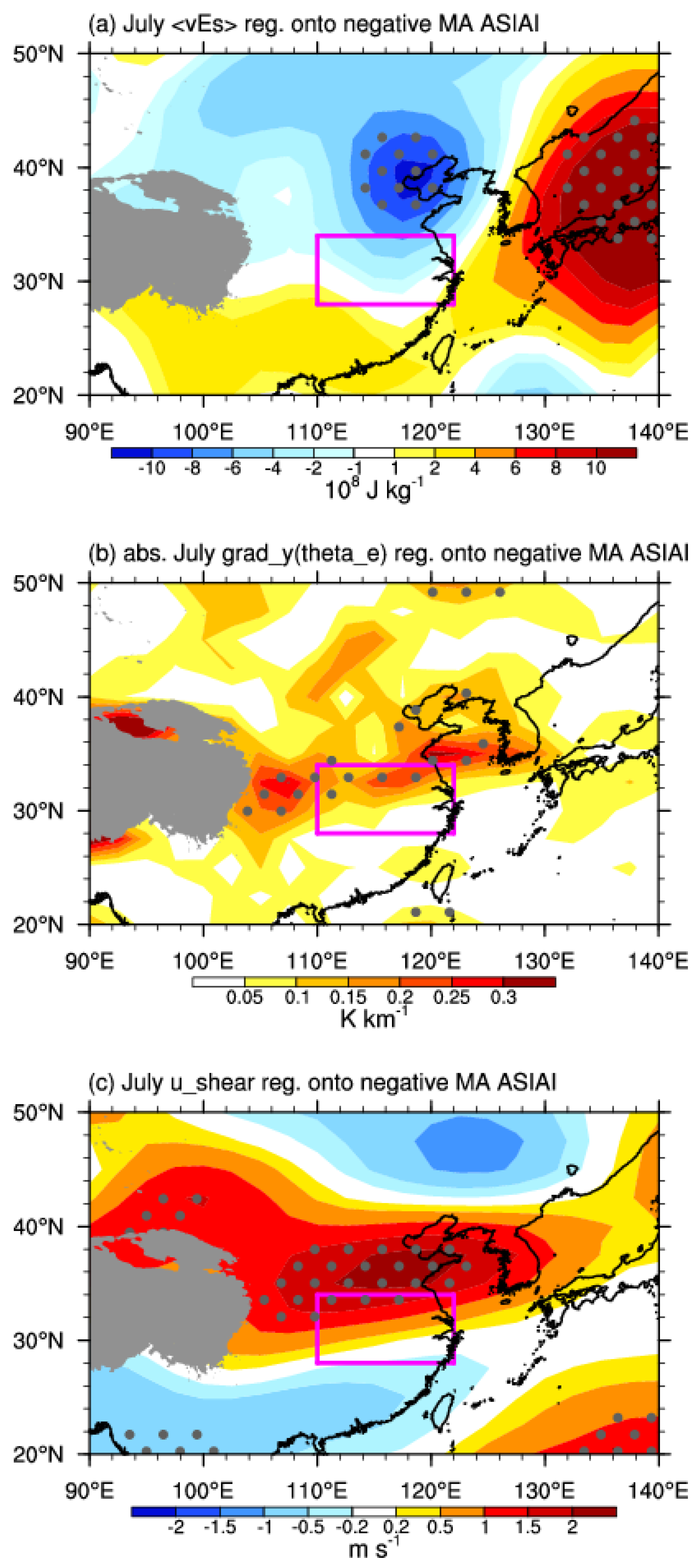
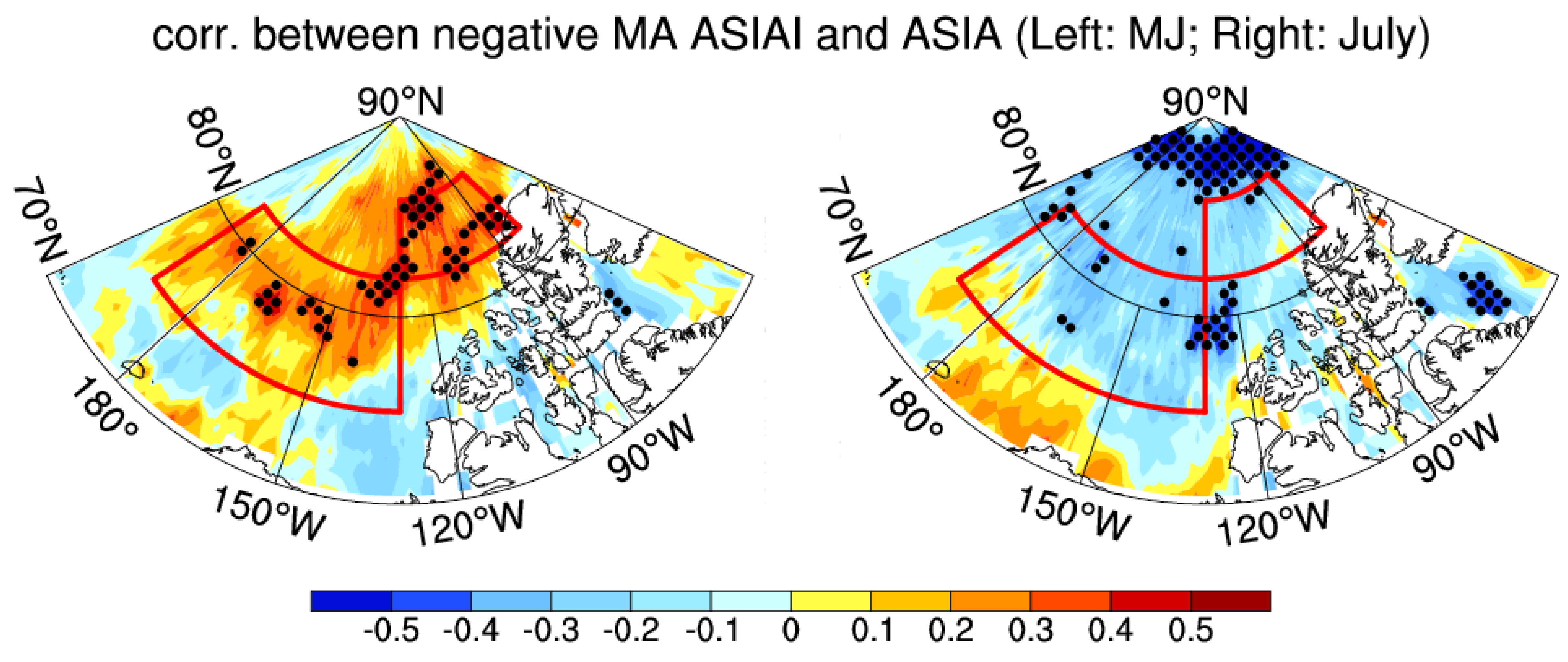


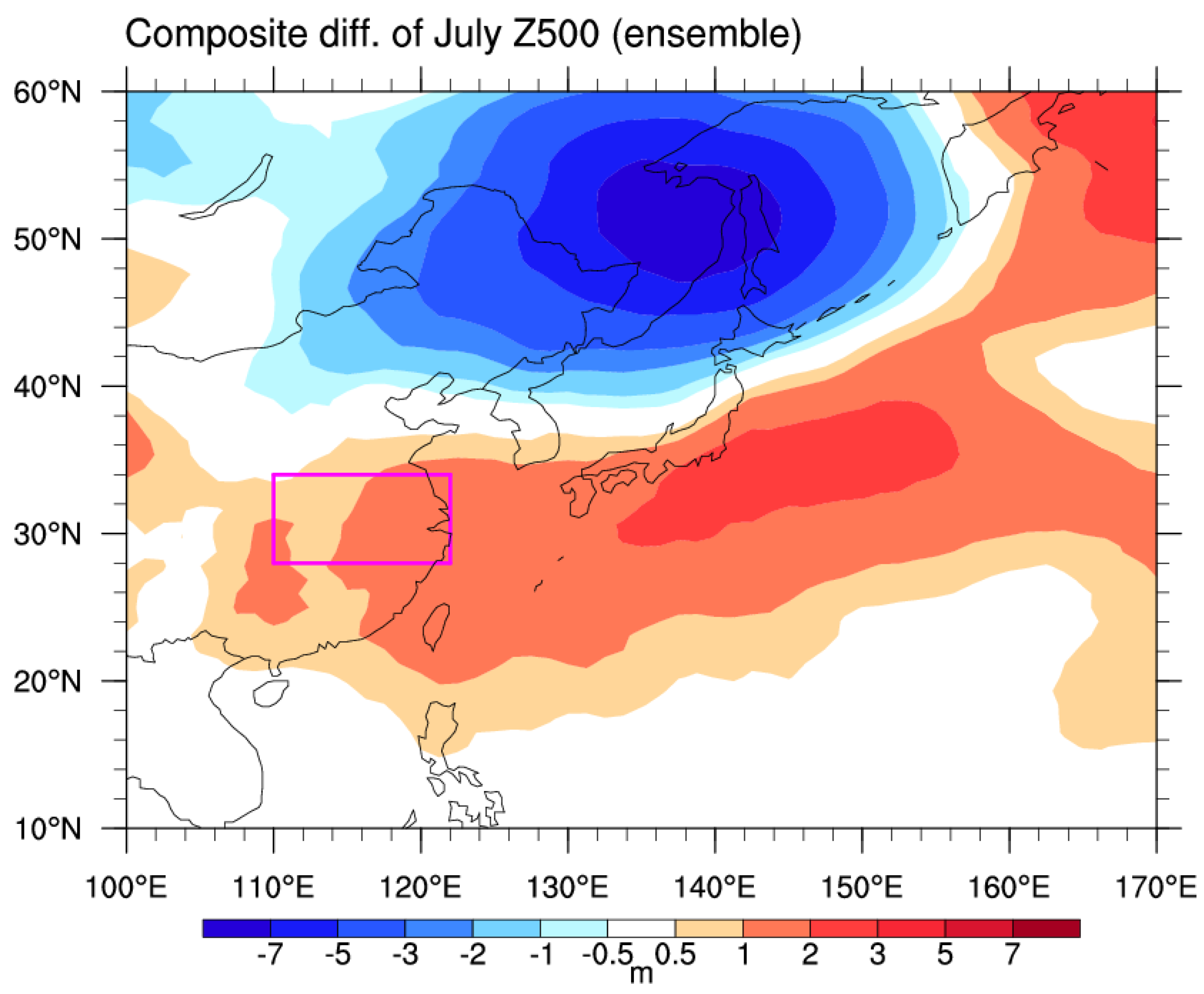
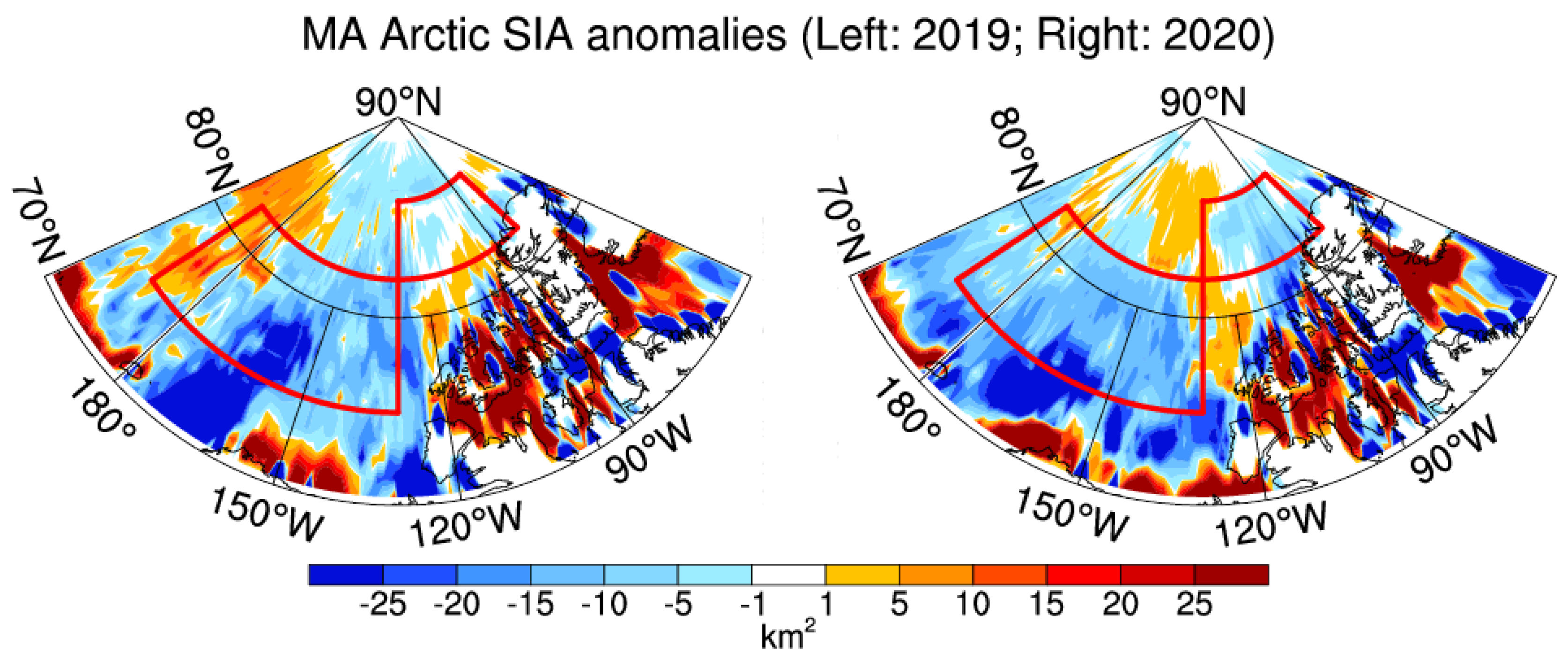
Publisher’s Note: MDPI stays neutral with regard to jurisdictional claims in published maps and institutional affiliations. |
© 2022 by the authors. Licensee MDPI, Basel, Switzerland. This article is an open access article distributed under the terms and conditions of the Creative Commons Attribution (CC BY) license (https://creativecommons.org/licenses/by/4.0/).
Share and Cite
Wang, J.; Fu, N.; Liang, P.; Li, M. Possible Impact of Early Spring Arctic Sea Ice on Meiyu Cessation over the Yangtze–Huaihe River Basin. Atmosphere 2022, 13, 1293. https://doi.org/10.3390/atmos13081293
Wang J, Fu N, Liang P, Li M. Possible Impact of Early Spring Arctic Sea Ice on Meiyu Cessation over the Yangtze–Huaihe River Basin. Atmosphere. 2022; 13(8):1293. https://doi.org/10.3390/atmos13081293
Chicago/Turabian StyleWang, Jing, Ning Fu, Ping Liang, and Mingcai Li. 2022. "Possible Impact of Early Spring Arctic Sea Ice on Meiyu Cessation over the Yangtze–Huaihe River Basin" Atmosphere 13, no. 8: 1293. https://doi.org/10.3390/atmos13081293
APA StyleWang, J., Fu, N., Liang, P., & Li, M. (2022). Possible Impact of Early Spring Arctic Sea Ice on Meiyu Cessation over the Yangtze–Huaihe River Basin. Atmosphere, 13(8), 1293. https://doi.org/10.3390/atmos13081293






